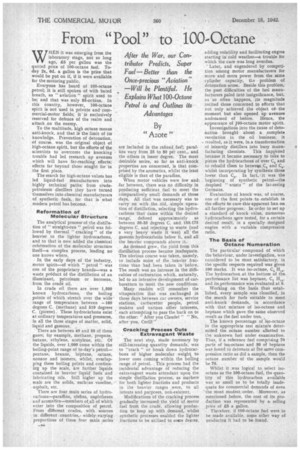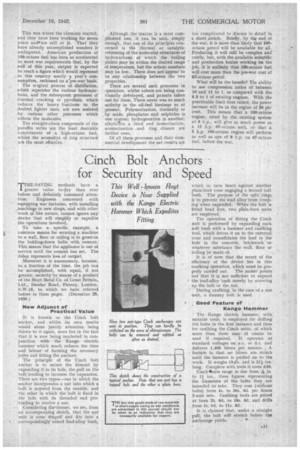From "Pool" to 100Octane
Page 32

Page 33

If you've noticed an error in this article please click here to report it so we can fix it.
After the War, our Contributor Predicts, Super Fuel— Better than the Once-precious "Aviation" —Will be Plentiful. He Explains What 100-Octane Petrol is and Outlines its Advantages By " Azote "
WHEN it was emerging from the laboratory stage, not so long ago, £5 per. gallon was the quoted price of 100-octane fuel. Today 2s... ticl. a gallon is the 'price that would be put on if, if it were available for the motoring public.
Everyone has beard of 100-octane petrol; it is still spoken of with bated breath, as " aviation " spirit used to be; and that was only 85-octane. In this country, however, 100-octane spirit is not used in private and eonsrnercial-motor fields; it' is exclusively reserved for defence of the realm and attack _on the enemy. To the multitude, high octane means anti-knock, and that is the limit of its knowledge. Prevention of detestation, of course, was the original object of high-octane spirit, but the efforts of the scientists to overcome the knocking trouble had led research up avenues which will have far-reaching effects; effects far beyond those sought for in the first place.
The search for high-octane values has led liquid-fuel manufacturers into highly technical paths; from crudepetroleum distillers they have turned themselves into chemical manufacturers of synthetic fuels, for that is what modern petrol has become. .
Reformation of Molecular Structure The analytical process' of the distillation of " straightsrun " petrol was followed by thermal " cracking " of the heavier to the lighter hydrocarbons, and to that is now added the chemical refotmation of the molecular structure itself—a complex process, leading no one knows where.
In the early days of the industry, motor Spirit—of which " petrol " Was one of the proprietary brands—was a waste product of the distillation of an illuminant, petroleum or kerosene, from the crude oil.
In crude oil there are over 1,500 known hydrocarbons, the boiling points of which stretch over the wide range of temperature between -160 degrees C. (methane) and 519 degrees C. (picene). These hydrocarbons exist at ordinary temperatures and pressures, in all the three stages of matter, solid, liquid and gaseous. , There are between 40 and SO of these gases; for example, methane, propane, butane, ethylene, acetylene, etc. Of the liquids, over 1,000 come within the boiling-point range of to-day's petrol— pentane, hexane, heptane, octane, nonane and isomers, whilst, overlapping these boiling points and continuing up the scale, are further liquids contained in heavier liquid fuels and lubricating oils. Still higher up the scale are the solids, such-As vaseline, asphalt, etc.
There are four main series of hydrocarbons—paraffins, olefins, naphthenes and aromatics—members ()Lail of which enter into the composition of petrol. From different crudes, with sources . in different countries, widely varying 'proportions of these four main series are included in the refined fuel; paraffins vary from 25 to 80 per cent., and the others in lesser degree. The most desirable series, so far as anti-knock properties are concerned, is that comprised by the aromatics, whilst the least eligible is that of the paraffins.
When motor vehicles were few and, -far between, there was no difficulty-in producing sufficient, fuel to meet the comparatively small demands of those days. All that was necessary was to carry on with the old, simple operation of distillation, selecting the hydrocarbons that came within the desired range, defined approximately as between 30-35 degrees C. and 150-175 degrees C. and rejecting to waste (and a very heavy waste it Was) all_ the gaseous hydrocarbOns below it, and all the heavier compounds above it.
As demand grew, the yield from this distillation process became inadequate. The obvious course was taken, namely, to include more of the heavier fractions than had been taken in before. The result was an increase in the difficulties of carburation which, naturally, led to an intensive development of carburetters to meet the new conditions.
Many readers will remember the vituperation that was exchanged in those days between car owners, service stations, carburetter people, petrol makers and various other interests, each attempting to pass the buck on to the other: "After you Claude! " "No, after you, Cecil!"
Cracking Process Outs . Extravagant Waste The next step, made necessary by still-increasing quantity demands, was to "crack " or break down hydrocarbons of higher molecular weight to lower ones coming within the boiling range of petrol. . This process had the incidental advantage of reducing the extravagant waste attendant upon the simple distillation process, as markets for both lighter fractions and products in the heavier ranges were, to all intents and purposes, non-existent.
Modifications of the cracking process gradually increased-dhe yield of motor fuel from the crude, allowing productiop to keep up with demand, whilst synthetic processes enabled the lighter fractions to be utilized to, soesie degree. adding volatility and facilitating engine starting in cold weather—a trouble for which the care was long overdue.
. ' Later, and engendered by competition among motor manufacturers for more and more power from_ the same cylinder capacity, the problem of detonation arose. Beside this problem, the past difficulties of the fuel manufacturers paled bite insignificance, but, as 'so often happens, its magnitude incited those concerned to efforts that not only achieved the object of the moment but also opened up avenues undreamed of before. Hence, the appearance of 100-octane motor spirit.
Investigations into the cause of detonation brought about a _complete revolution in the oil business; it -.resulted, as it were, in a transformation of leisurely distillers into busy manufacturing chemists. This happened because it became necessary to take to pieces the hydrocarbons of over C. and to rebuild them to between,C, and C., whilst incorporating by synthesis those lower than C.. In fact, it was the beginning of synthetic petrol—the despised " ersatz " of the far-seeing Germans.
' Evaluation of knock was, of course, one of the first points to establish in the efforts to cure this apparent ban on all further progress: In order to set up astandard of knock value, numerous hydrocarbons %ere tested, for a certain desired result, in a specially designed engine with a variable compression ratio.
The Basis of
Octane Numeration The particular compound of which the behaviour, under investigation, was considered to be most satisfactory, in the specific respects required was given 100 marks. It was iso-octane, C. H,m The hydrocarbon at the bottom of the performatice list was heptane, C7 HI., and its performance was evaluated at 0.
Working on the basis thus established, every sample was classified, in the, search for fuels suitable to meet anti-knock demands, in accordance with that mixture of iso-octane and heptane which gave the same observed result as the fuel under test.
The known percentage of iso-octane in the appropriate test mixtui.e determined the octane number allotted to the unknown fuel under examination. Thus, if a reference fuel comprising 70 parts of iso-octane and 30 of heptane was found to detonate at the same compression ratio as did a sample, then the octane number of the sample would be 70.
Whilst it was logical to select isooctane as the 100-octane fuel, the quantity of this hydrocarbon available was so small as to be totally inadequate for commercial demands of even -the most modest r order. Moreover, as mentioned before, the cost of its production was represented by a. selling price of £5 a gallon.
Therefore, if 100-octane fuel were to be made available, some other way of producing it had to be found.
This was where the 'chemists started, and they have been 'working for seven years andoire still at it. That they have already accomplished wonders is undisputed. American production of 100-octane fuel has been so accelerated to meet war requirements that, by the end of this year, output is expected to reach .a figure which would represent in this country nearly a year's consumption, reckoned on a re-war basis.
The ceiginal process of distillation, which separates the various hydrocarbons, and the subsequent processes of thermal cracking or pyrolesis, which reduces the heavy fractions to the desired lighter ones, are now assisted by various other processes which reform the molecules.
The straight-chain compounds of the ' paraffin series are the least desirable constituents of a high-octane. fuel, whilst the aromatics of ring structure are the most effective. Although the matter is a most com• plicated one, it can. be said, simply enough, that one of the principles concerned is the thermal or catalytic reforming of the molecular structures of hydrocarbons of which the boiling points may be within the desired range of temperature, but the octane numbers may be low. There does not appear to be any relationship between the two properties.
There are several such processes in operation, whilst others are being continually deteloped, and patents taken out for them. There never was so much activity in the oil-fuel business as at present. Polymerization, thermally or by acids, phosphates and sulphides is one system; hydrogenation is another: alkylation a third and isomerization, arornatization and ring closure are further ones.
Of all these processes and their commercial development the net results are
too complicated to discuss in detail in a short article. Briefly, by the end of the war, it is more than likely that 100octane petrol will be available for Producing it will still be complex and costly, but, with the available scientific and production brains working on the job, it is tmlike,ly that 100-octane fuel will cost more than the pre-war cost of 67-octane petrol.
What will be the benefit? The ability to use compression. ratios of between 10 and 11. to 1, as compared with the 8.3 to 1 of existing engines. With the practicable limit thus raised, the power increase will be in the region of 50 per cent. This means that a 100-octane engine, rated by the existing system at 8 h.p., will give as much power as a 12 h.p. 67-octane unit, or that a 5 h.p. 100-octane engine will perform as well as .ene of 13 hp. on 67-octane fuel, before the war,




















































